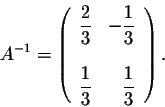 Invertible Matrices
Invertible Matrices Invertible Matrices
Invertible Matrices
Invertible matrices are very important in many areas of science. For example, decrypting a coded message uses invertible matrices (see the coding page). The problem of finding the inverse of a matrix will be discussed in a different page (click here).
Definition. An ![]() matrix A is called nonsingular or invertible iff there exists an
matrix A is called nonsingular or invertible iff there exists an ![]() matrix B such that
matrix B such that
Example. Let


Notation. A common notation for the inverse of a matrix A is A-1. So
Example. Find the inverse of





The inverse matrix is unique when it exists. So if A is invertible, then A-1 is also invertible and
The following basic property is very important:
Remark. In the definition of an invertible matrix A, we used both ![]() and
and ![]() to be equal to the identity matrix. In fact, we need only one of the two. In other words, for a matrix A, if there exists a matrix B such that
to be equal to the identity matrix. In fact, we need only one of the two. In other words, for a matrix A, if there exists a matrix B such that
![]() ,
then A is invertible and
B = A-1.
,
then A is invertible and
B = A-1.
More on invertible matrices and how to find the inverse matrices will be discussed in the Determinant and Inverse of Matrices page.

